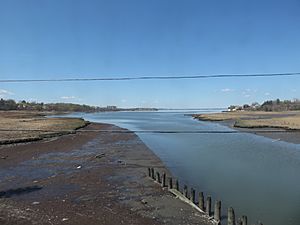Little Neck Bay facts for kids
Little Neck Bay is a beautiful bay located on the western side of Long Island in New York. It's a part of the larger Long Island Sound. This bay helps form the edge of the Great Neck Peninsula on its western side. On the other side of the peninsula is another bay called Manhasset Bay.
Little Neck Bay also sits right on the border between two important areas: Nassau County and the borough of Queens. The neighborhood of Douglaston–Little Neck in Queens is right next to the bay.
Exploring Little Neck Bay
At the entrance to Little Neck Bay, on the western side, you'll find a place called Willets Point. This is where Fort Totten is located. This old fort was built a long time ago to help protect the entrance to the East River, which is a narrow waterway nearby.
On the eastern side of the bay's entrance is Elm Point, which is at the end of Steamboat Road in Kings Point. The bay is about one mile wide at its entrance and stretches back almost two miles inland.
Bay Features and Depth
In the past, the western and southern parts of the bay had large areas of salt marshes. These are special wetlands where salty water from the bay mixes with fresh water.
You can also find Saddle Rock on the eastern side of the bay, about halfway in. Little Neck Bay is not very deep. At its entrance, it's only about 12 feet (3.7 m) deep. Most of the inner part of the bay is even shallower, less than 6 feet (1.8 m) deep.
Near the southern and southwestern shores, you'll find Alley Pond Park. A stream called Alley Creek flows into the bay from this park.
History of Little Neck Bay
For a very long time, Native American groups lived around Little Neck Bay. When Europeans first arrived, the Native Americans in this area were often thought to be part of a tribe called the Matinecock. However, some historians now believe this idea might not be completely accurate.
Famous Clams
From the 1860s to the 1890s, Little Neck Bay became famous for its small, tasty hard clams, also known as quahogs. These clams were so popular that they were served in the best restaurants in New York City and even in some European cities!
Because of this, the name "littleneck" or "littleneck clam" eventually became a way to describe a certain size of hard clam, no matter where it came from. You can also find "saddle-rock oysters" in the bay.
Unfortunately, due to pollution, the bay was closed for clam and oyster harvesting in 1909. This means people could no longer collect seafood from the bay because it wasn't safe to eat.



